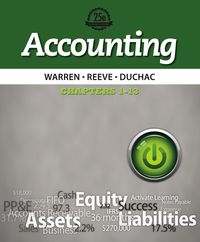


1. Which of the following transactions is NOT recorded in the accounts of a business? a) Receipt of interest by business owner on bank fixed deposit held jointly with spouse. b) Sale of an asset on credit. c) Withdrawal of goods by the business owner for personal consumption. d) Purchase of a new asset in exchange of an old asset. 2. Which of the following is NOT a current asset? a) Accounts receivable b) Inventories c) Prepaid expenses d) Income received in advance 3. Who among the following is NOT an internal user of financial statements? * a) Board of directors b) Investors c) Managers d) Employees 4. Listed below are some possible causes of difference between the cash book balance and the bank statement balance when preparing a bank reconciliation statement. Which of these items require an entry in the cash book? (0 Cheque paid in but subsequently dishonoured (ii) Error by bank (iii) Bank charges (iv) Lodgement credited after date (a)(ii) and (iii) only (b) (i) and (iii) only (ii) and (iv) only (d) (i) and (iv) only 5. Which of the following is correct? a) A credit entry will decrease drawings; A credit entry will increase profit; A credit entry will decrease non-current assets b) A debit entry will increase non-current asset; A debit entry will decrease drawings; A credit entry will increase payables c) A debit entry will increase profit; A credit entry will decrease drawings; A credit entry will increase bank overdraft d) A debit entry will increase bank overdraft; A debit entry will decrease payables; A credit will increase profit 6. Which of the following statements about bank reconciliations are correct? 0 A difference between the cash book and the bank statement must be corrected by means of a journal entry () In preparing a bank reconciliation, lodgements recorded before date in the cash book but credited by the bank after date should reduce an overdrawn balance in the bank statement. (iii) Bank charges not yet entered in the cash book should not be dealt with by an adjustment in the bank reconciliation statement. (iv) If a cheque received from a customer is dishonoured after date, a credit entry in the cash book is required. (a)(ii) and (iii) only (b) (i) and (iv) only (ii) and (iv) only (d) (i) and (iii) only 7. How is a bank overdraft classified in the statement of financial position? a) Current asset b) Non-current asset c) Non-current liability d) Current liability 8. Which of the following is an example of a liability? a) Inventory b) Receivables c) Plant and equipment d) Loan 9. Which of the following would not be identified by extracting a trial balance? a) Two credit entries and no debit b) One-sided entry c) Two debit entries and no credit d) Transaction omitted completely 10. What must be done with a suspense account before preparing a statement of financial position? a) Write it off to capital b) Include it in assets c) Clear it to nil d) Include it in liabilities 11. Which of the following is the correct formula for cost of sales? a) Purchases - closing inventory + sales b) Opening inventory - purchases + closing inventory c) Opening inventory + closing inventory - purchases d) Opening inventory - closing inventory + purchases 12. if an owner takes goods out of inventory for their own use, how is this dealt with? a) Debited to drawings at cost b) Credited to drawings at selling price c) Debited to drawings at selling price d) Credited to drawings at cost 13. You have bought stationery with a company cheque from the stationery shop next door. How should this transaction be recorded? a) Debit Cash Credit Payable b) Debit Payable Credit Cash c) Debit Stationery Credit Payable d) Debit Stationery Credit Cash 14. Which one of the following can the accounting equation be rewritten as? a) Assets + profit - drawings - liabilities = closing capital b) Assets - liabilities - drawings = opening capital + profit c) Assets - liabilities - opening capital + drawings = profit d) Assets - profit - drawings = closing capital - liabilities









